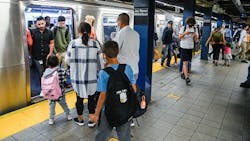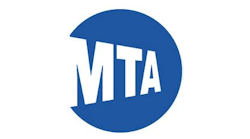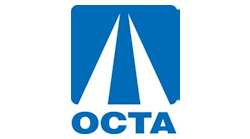Ridership milestones on OCTA, MTA and Colorado transit systems
Several public transit service providers throughout the United States marked positive ridership milestones this past week. The gains were driven by students returning to class for the fall term, promotional fares and a deliberate, gradual return to service.
In California, Orange County Transportation Authority (OCTA) has achieved 100,000 average weekday riders for the first time since the start of the COVID-19 pandemic. OCTA says it has put an emphasis on the gradual, safe restoration of bus service, along with the implementation of programs that make riding the bus free for students and youth throughout Orange County.
“During the height of the pandemic, we saw a sharp decline in bus ridership,” said OCTA Chairman Mark A. Murphy, also the Mayor of Orange. “Now, it’s highly encouraging to see this steady climb, which is only possible through thoughtful planning, the hard work of coach operators and OCTA staff, and good relationships built with the community.”
Prior to the pandemic, the OC Bus system saw an average of nearly 120,000 riders per day. That number dropped in March and April 2020 to approximately 33,000 daily riders at its lowest. The recently reported 100,000 average weekday riders represents 88 percent of pre-pandemic ridership levels.
Metropolitan Transportation Authority
In New York, Metropolitan Transportation Authority (MTA) saw several ridership milestones including the New York City bus and subway system carrying more than five million riders on Sept. 8, the first day of school for the city’s students.
Subways set a ridership record on Thursday, Sept. 8, carrying 3,641,033 riders, a 34.8 percent increase from the comparable day in 2021. The record set is the highest day of subway ridership since the onset of the COVID-19 pandemic. Bus ridership hit the 1.4 million-mark on the same day, with a preliminary total of 1,412,574 riders, which is expected to rise by approximately 15 percent when the rider count is complete.
In preparation for the new school year, the MTA deployed extra buses throughout all five boroughs on weekdays for the rest of the school year. Additionally, the MTA is providing customer ambassadors in the Bronx to help students, their families and caregivers navigate the new Bronx Local Bus Network Redesign routes which began in June.
"NYC Transit has prepared for the return of students all summer, and we are happy to have them back. We are looking at ways to increase the frequency of buses and trains and reduce travel times to make sure everyone makes it to school in time for first period,” said New York City Transit President Richard Davey.
The city’s transit milestone came just a day after MTA’s commuter railroad, Metro-North Railroad and Long Island Rail Road (LIRR), both set single weekday records. LIRR surpassed 200,000 riders on a weekday and Metro-North carried a record 179,268 riders, which surpassed the railroad’s previous record set in June.
MTA reports both LIRR and Metro-North rolled out fare offerings including a 10 percent discount for monthly passes, and a new 20-trip ticket tailored for the hybrid work schedule. The new 20-trip ticket saves riders 20 percent on regular peak one-way fares. For commuter rail riders traveling within the five boroughs the MTA also expanded City Ticket, which offers a reduced, flat fare of $5.00 for rail travel within New York City on weekends, to include all weekday off-peak trains.
"The commuter railroads remain the most convenient way to get to New York City from Long Island, the Hudson Valley and Connecticut. For customers who are returning after a while, commuting has never been easier. Customers can now use the new all-in-one TrainTime app to purchase tickets, plan trips, view train capacity, and track trains for both commuter railroads. And with the fare discounts we rolled out earlier this year, taking the train is a no brainer,” said Metro-North President and LIRR Interim President Catherine Rinaldi.
Colorado – zero fare is a success
The state of Colorado implemented a one-month zero-fare pilot program during August that granted free access on all transit system throughout the state. The Zero Fare for Better Air campaign, based on ridership numbers, was a success.
According to data released by the Colorado Association of Transit Agencies (CASTA), 14 agencies reported ridership increases including by 40 percent or more in Archuleta County, Mountain Metro, Pueblo and Southern Colorado Community Action Agency/RoadRunner Transit.
“Transit plays such an important role in our state from connecting people to employment, education and services to helping reduce air pollution by providing people with cleaner travel options,” said CASTA Executive Director Ann Rajewski.

Mischa Wanek-Libman | Group Editorial Director
Mischa Wanek-Libman is director of communications with Transdev North America. She has more than 20 years of experience working in the transportation industry covering construction projects, engineering challenges, transit and rail operations and best practices.
Wanek-Libman has held top editorial positions at freight rail and public transportation business-to-business publications including as editor-in-chief and editorial director of Mass Transit from 2018-2024. She has been recognized for editorial excellence through her individual work, as well as for collaborative content.
She is an active member of the American Public Transportation Association's Marketing and Communications Committee and served 14 years as a Board Observer on the National Railroad Construction and Maintenance Association (NRC) Board of Directors.
She is a graduate of Drake University in Des Moines, Iowa, where she earned a Bachelor of Arts degree in Journalism and Mass Communication.




